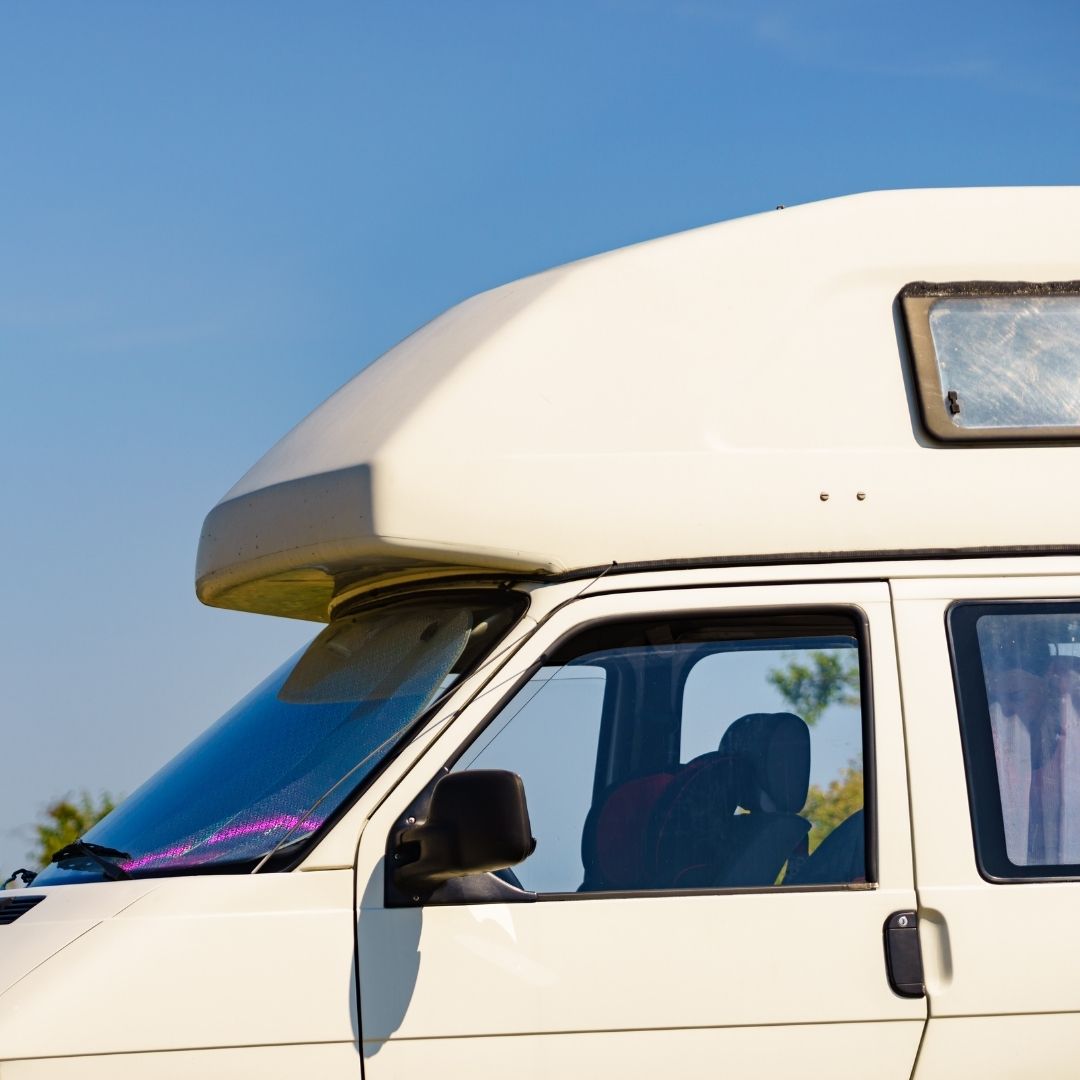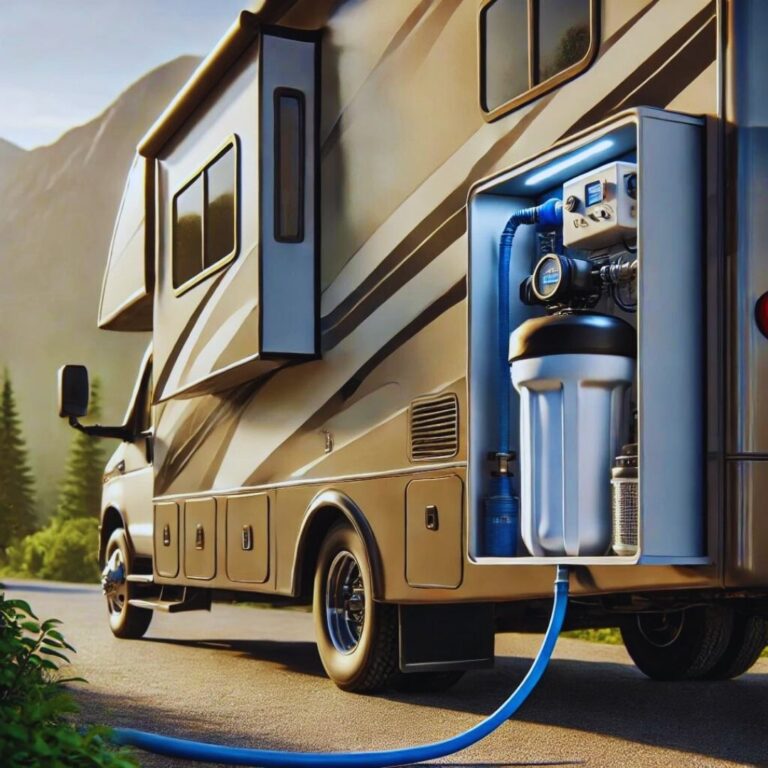How to Winterize a Camper with a Water Filter: All You Need to Know

Winter is quickly approaching which means it’s time to start getting our campers ready for the colder months ahead. As temperatures drop, one of the most important preparations is to winterize your freshwater systems. While not all campers have identical water system setups, winterizing is an essential process for any RV with indoor plumbing!
Today, I’m sharing a complete guide for how to winterize a campervan that has a water filter installed. Following the proper steps is vital to keep your water lines safe from freezing no matter how low the mercury dips. So whether you plan to use your camper year-round or store it away until spring, this post will show you how to winterize a camper with a water filter with ease!

How to Winterize a Camper with a Water Filter
In this post, I’ll start by explaining exactly what winterizing a camper involves and why it’s necessary when you have a water filter system. Then, I’ll walk through the full process step-by-step so you can be fully prepared to protect your RV plumbing no matter what winter has in store.
Whether you need a refresher on the basics or are just learning to winterize for the first time, this guide will give you all the information required to complete the job correctly. Following these best practices is key to keeping your camper water systems in top operating condition season after season.
What Does it Mean to Winterize a Camper?
Winterizing a camper essentially means ensuring your freshwater system can withstand below-freezing temperatures. It’s the process of eliminating all water from your plumbing lines and replacing it with antifreeze. Leaving standing water in any part of the system poses a risk, as it can expand as it freezes and rupture pipes or tanks. Doing a thorough winterizing job is especially important for campers that have a water filter installed. If you don’t and you’re looking to get one, check out my post on Best Water Filters For Your RV.
Like any indoor plumbing, the water filter’s internal components are vulnerable to damage from frozen liquids. Protecting the entire fresh water system, including the filter itself, is key to keeping your setup functioning properly season after season. Winterizing helps guarantee your camper will be ready for use again come spring, without needing repair bills from freezing issues over winter.
When to Winterize a Camper with a Water Filter?
Most RV experts recommend winterizing your camper’s fresh water system before the first anticipated hard freeze of the season. This usually falls sometime between late October through early November in cooler regions. Completing the full winterizing process well in advance of sub-zero weather is best.
It generally takes a few hours to properly winterize, depending on your specific camper model and any personal experience level. But setting aside half a day ensures you have ample time to address any unexpected issues without rushing. Getting it done early also eliminates worries about waiting until icy conditions are already setting in.
Thoroughly following the steps shared here should allow most RVers to complete the entire winterizing process within 3-4 hours. Taking your time and double-checking each stage is worth it for peace of mind that your plumbing will be fully protected during winter storage until spring thaw arrives again. When done right just once before winter, your camper’s water systems will remain freeze-proofed until next season’s adventures.

What Do You Need to Winterize a Camper with a Water Filter?
- Gallons of antifreeze (usually 1-2 gallons depending on system size)
- Water heater bypass kit (if not installed)
- Buckets
- Cleaning wand (like a Flush King)
- RV winterizing hose/tubing
- Hand tools like adjustable wrenches
- Lubricant for valves (like WD-40)
How to Properly Winterize a Camper with a Water Filter:
Step 1: Consult manual and locate all drain plugs and valves.
This initial step is important for ensuring you don’t miss any parts of the system. Review where components like the fresh tank, water heater, drain plugs, and sink drains are positioned. Locating everything upfront makes future steps smoother.
Step 2: Drain the fresh water holding tank and filter housing.
Use an adjustable wrench to remove the fresh water tank drain plug. Also, locate the rubber filter housing cap to empty the residual water inside. Fully draining the filter saves antifreeze later.
Step 3: Drain the water heater.
Turn the power switches off and let the water heater cool before attempting this intricate process. Patience is key as you release pressure, unscrew the drain plug, and completely purge all water contents. Consult your owner’s manual if needed.
Step 4: Bypass the water heater if needed.
This step is only if your camper lacks a pre-installed bypass kit. Get professional help with installation so antifreeze isn’t circulated internally later during use. Completing this step is vital for water heater protection.
Step 5: Use a wand-type solution to flush the black water tank.
Thorough flushing cuts odors later and keeps waste lines clear. A product like Flush King makes fast work of scouring the tank empty before adding antifreeze.

Step 6: Drain the water tanks properly.
Emptying the black and gray holding tanks removes sources of potential freezing while sparing unpleasant spring discoveries. Take tanks to a dump station for legal draining.
Step 7: Connect tubing and distribute antifreeze.
Connect the tubing from your jug of RV antifreeze to the water pump inlet valve. This allows the pump to pressurize the lines and push the antifreeze through. Make sure to use tubing specifically rated for potable water use. Then, turn the water pump on and place the free end of the tubing into the antifreeze jug. This will start the flow.
Step 8: Check that all exterior point drains receive antifreeze.
Manually open each faucet, including kitchen and bathroom sinks, showers, and outside shower fixtures one at a time. Let the antifreeze flow through until you no longer see water coming out of the faucet. This ensures full protection. Ice makers will also need to receive antifreeze flow. Check exterior point drains and lowest faucets last to purge any trapped water.
Step 9: Check that the water heating element is switched off.
Double check the power switch on the water heater itself as well as the main power center switch are both in the OFF position. Then, go through the coach one more time and ensure that the faucets are closed.
Step 10: Attach included labels to pipes.
Affix the antifreeze warning labels near all antifreeze-filled pipes for next season. This prevents accidental ingestion. Consult your filter owner’s manual for steps to properly clean, remove from the RV, and store the filter cartridge unit until spring.
Follow these steps to winterize your RV camper successfully.
With winter fast approaching, now is the ideal time to ensure your camper’s plumbing remains fully ready for winter. Following these step-by-step instructions to winterize your freshwater system is key for RVers enjoying comfortable camping year-round.
Whether you plan to store your RV away or use it periodically through fall and winter, thoroughly completing the process provides peace of mind that your plumbing will remain undamaged. Doing it once before the first hard freeze spares expensive repairs down the road. Campers with properly winterized systems can rest easy knowing everything is ready for whenever the urge to venture out again overcomes cabin fever!
By taking the time to properly winterize your campervan, especially when a water filter is installed, you’ll be all set to make the most of every camping season. Your indoor plumbing will sail through sub-zero temps until spring’s thaw arrives to start the cycle anew. Tackling this important maintenance chore ensures many more travel-filled years with your RV home on the road.
For more information on beneficial water therapies and all things around the benefits of water, stay tuned to my blog. I’m always available to give recommendations, reviews, and health information around water.
If you found this particular post helpful, you might want to check out my posts on How to Choose a Camping Water Filter, How to Filter Water for a Camping Trip, and Best Water Filters for Camping.
Stay hydrated,
Shashank Varma (Mr. Water Geek)







